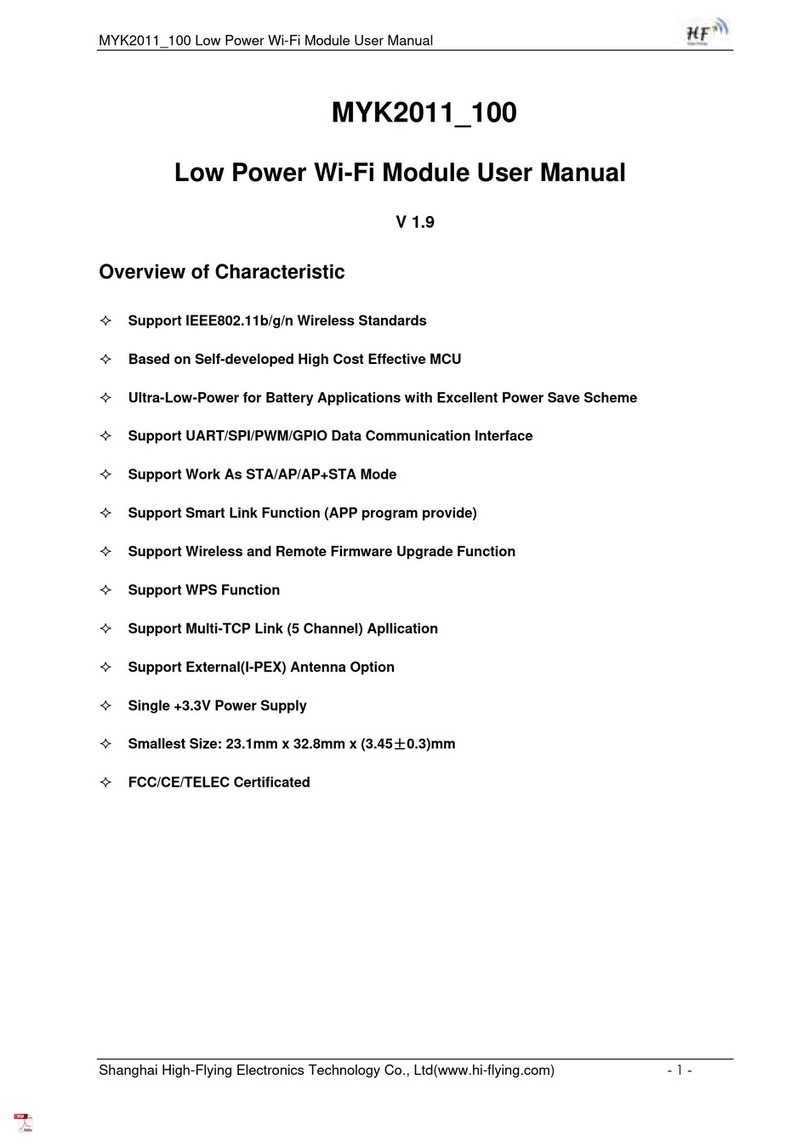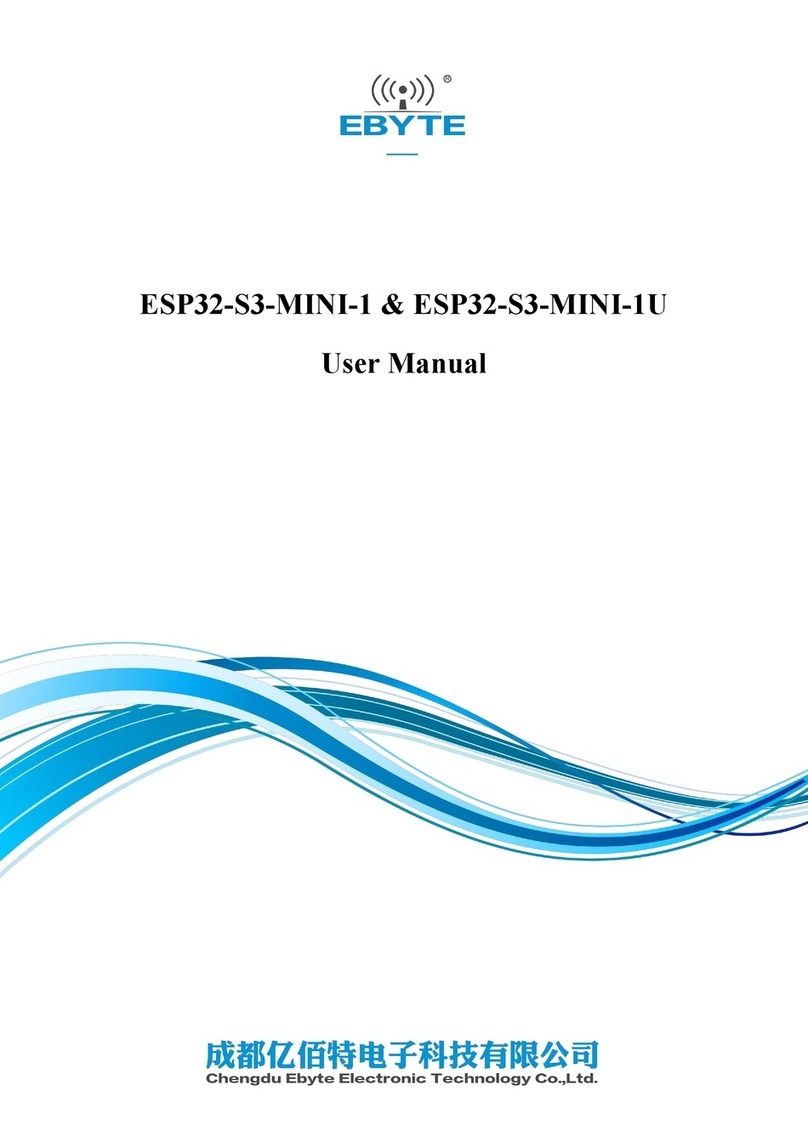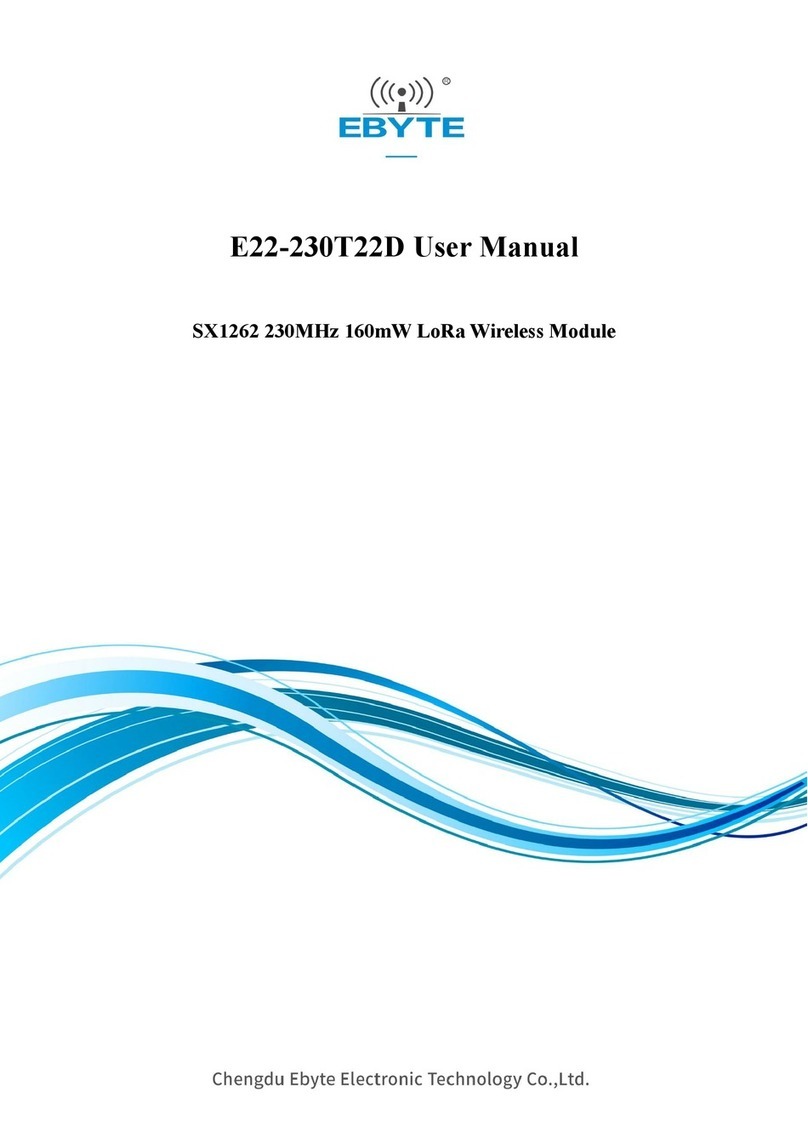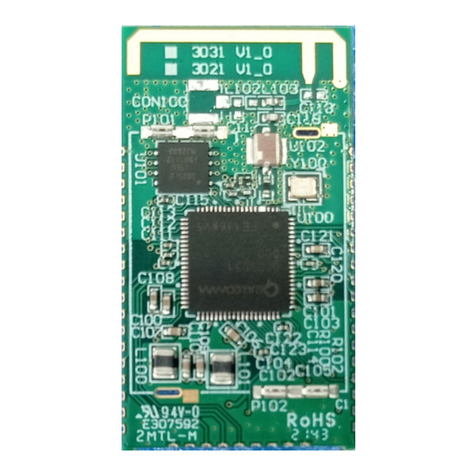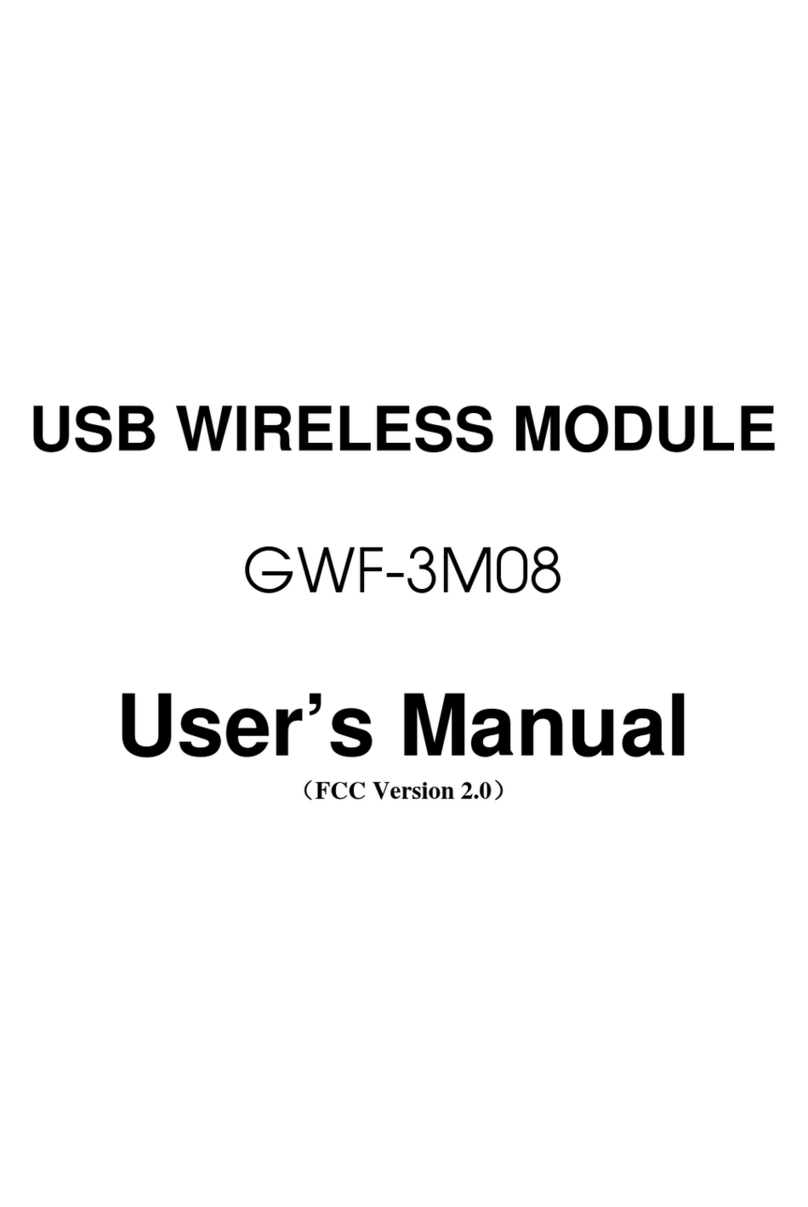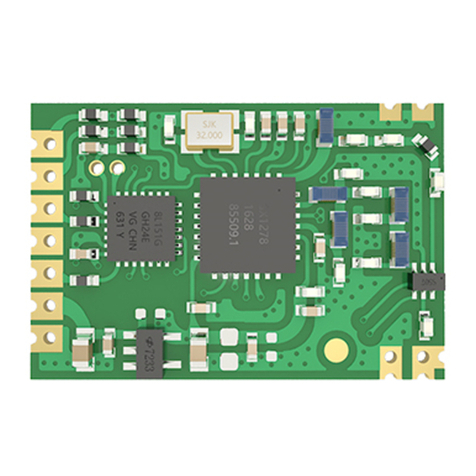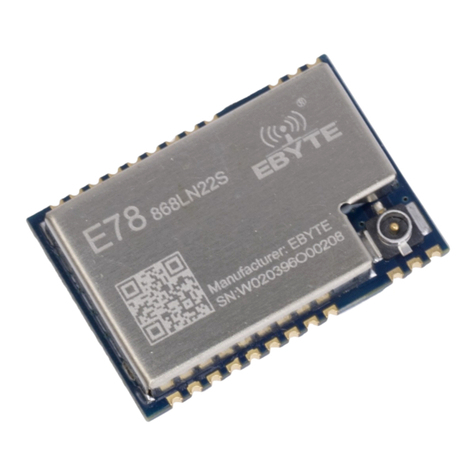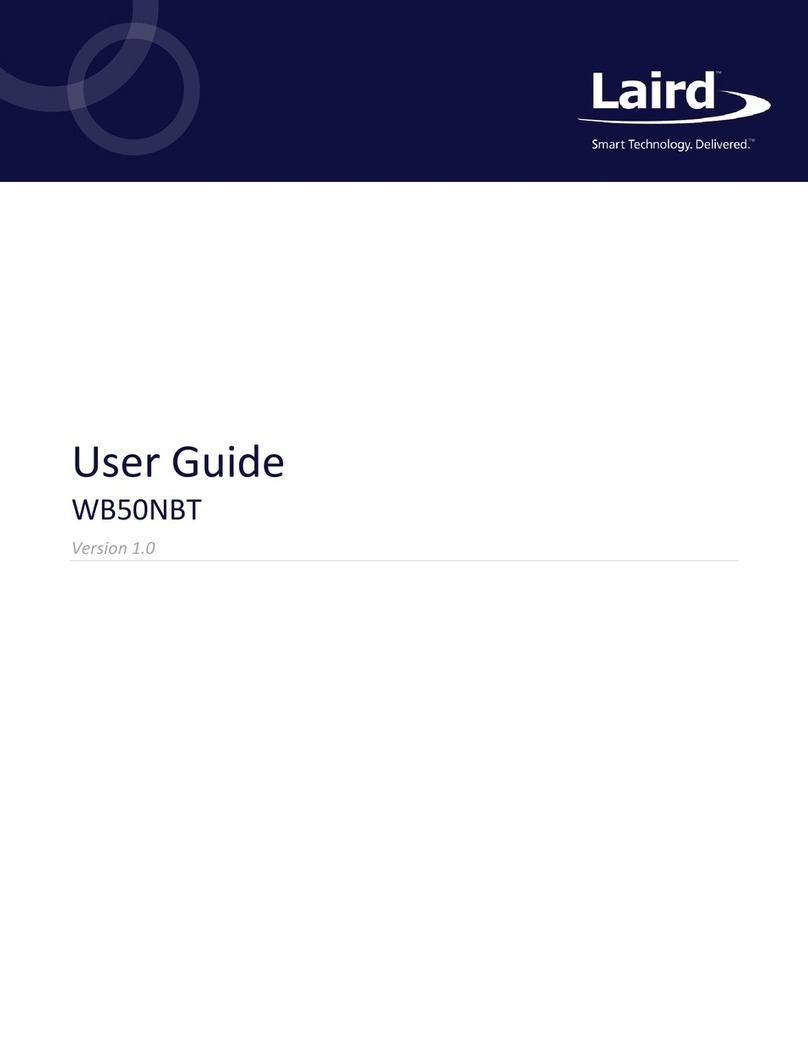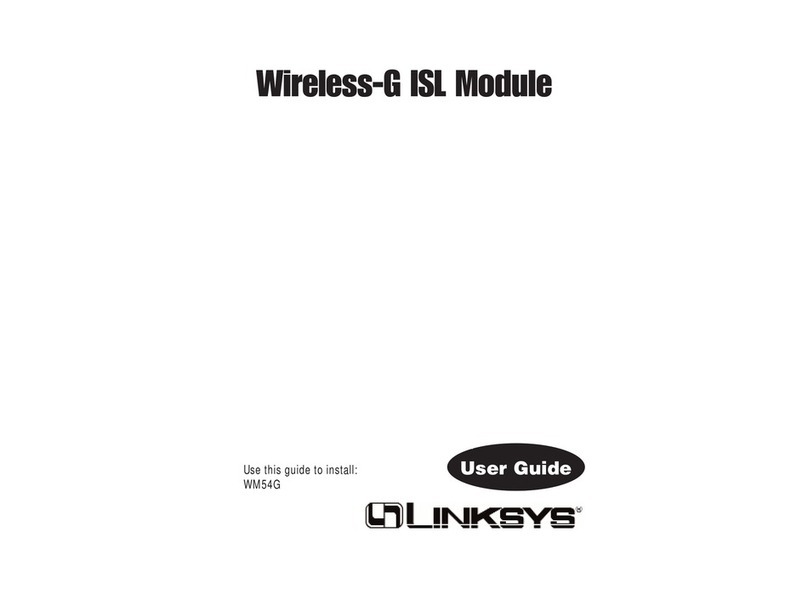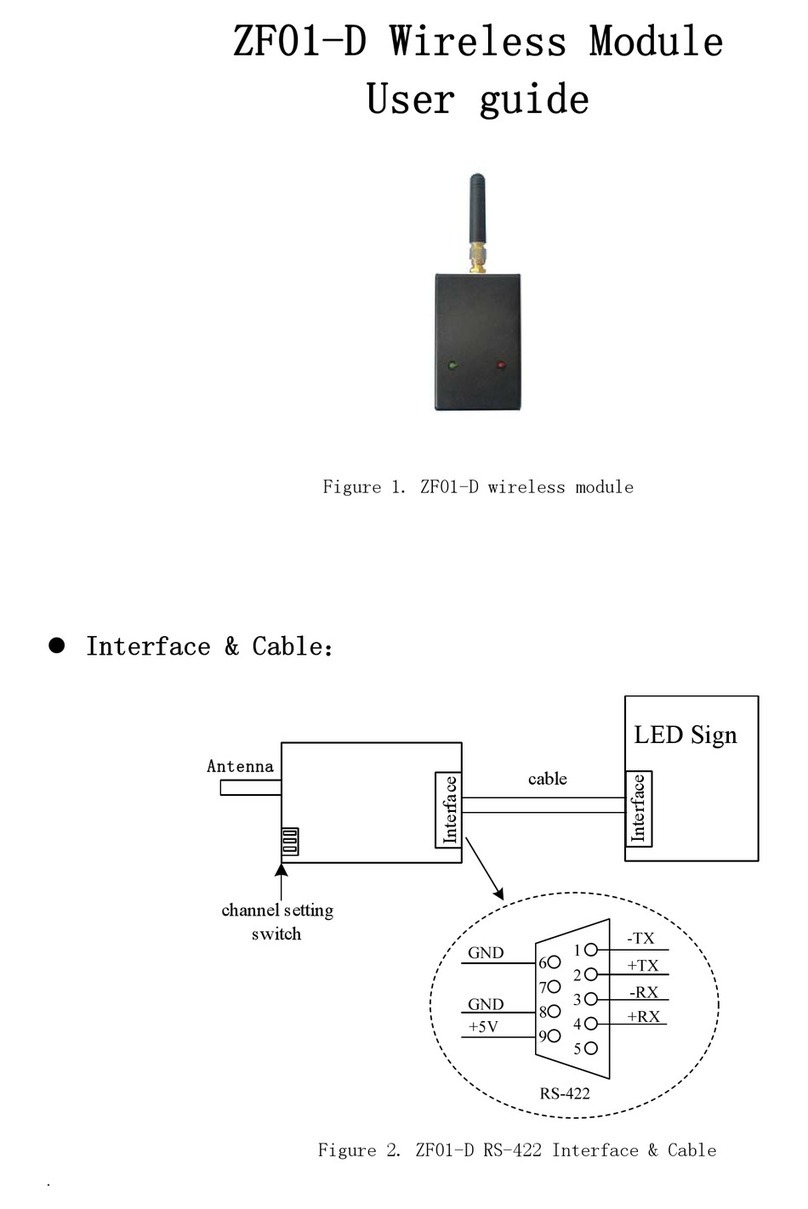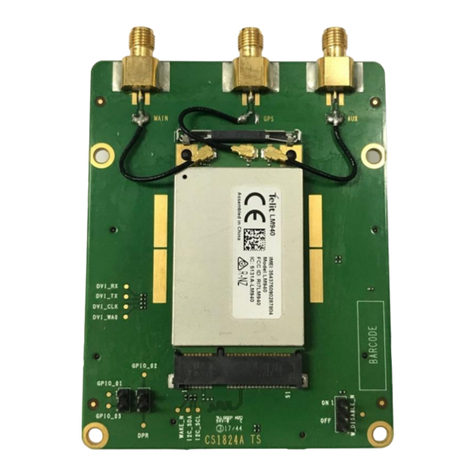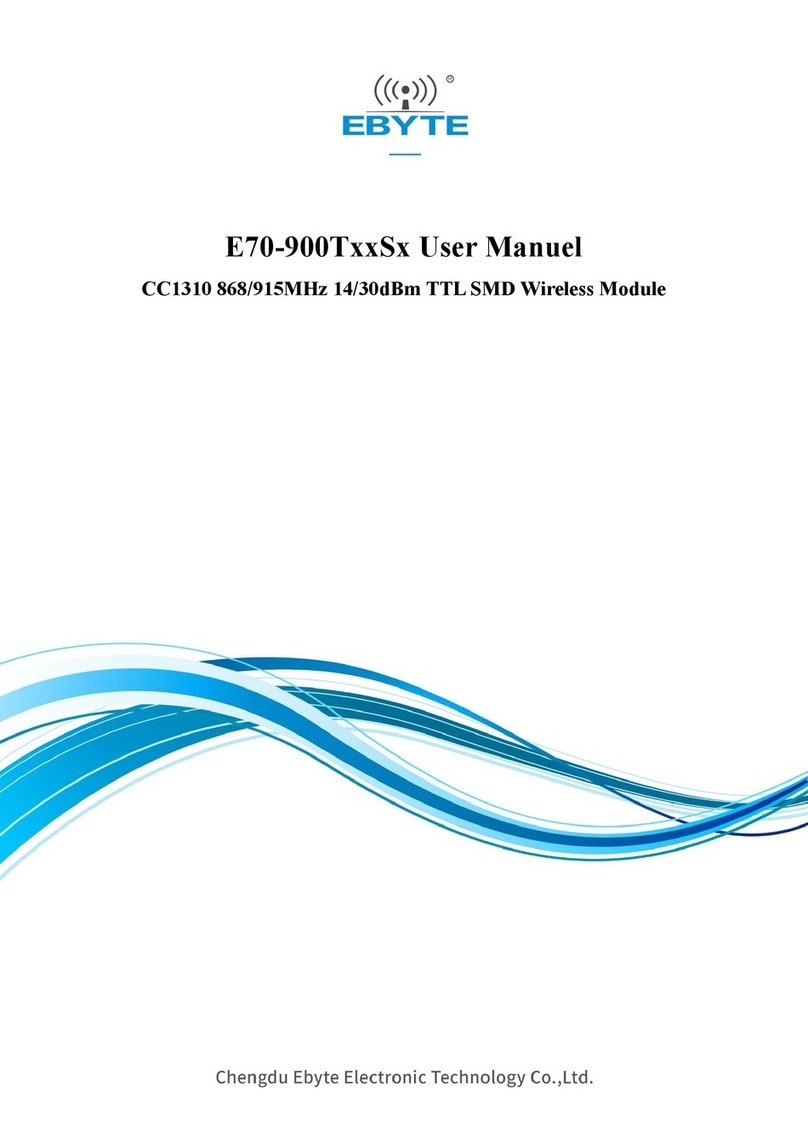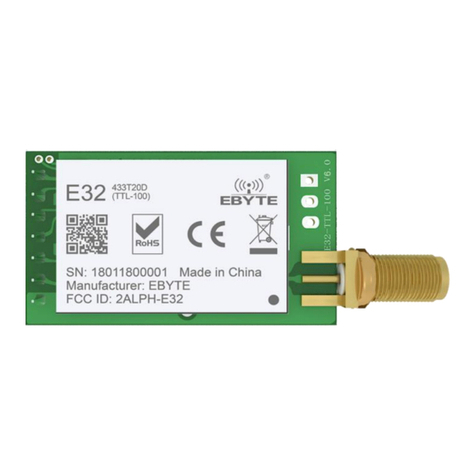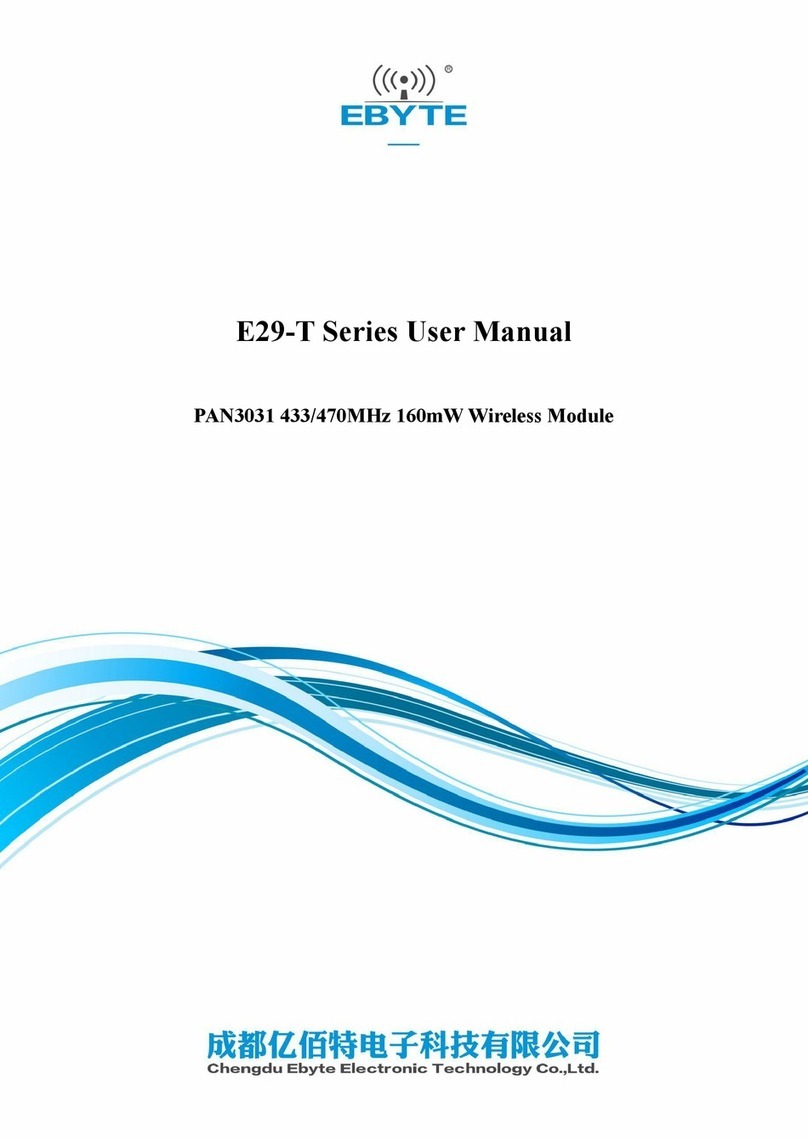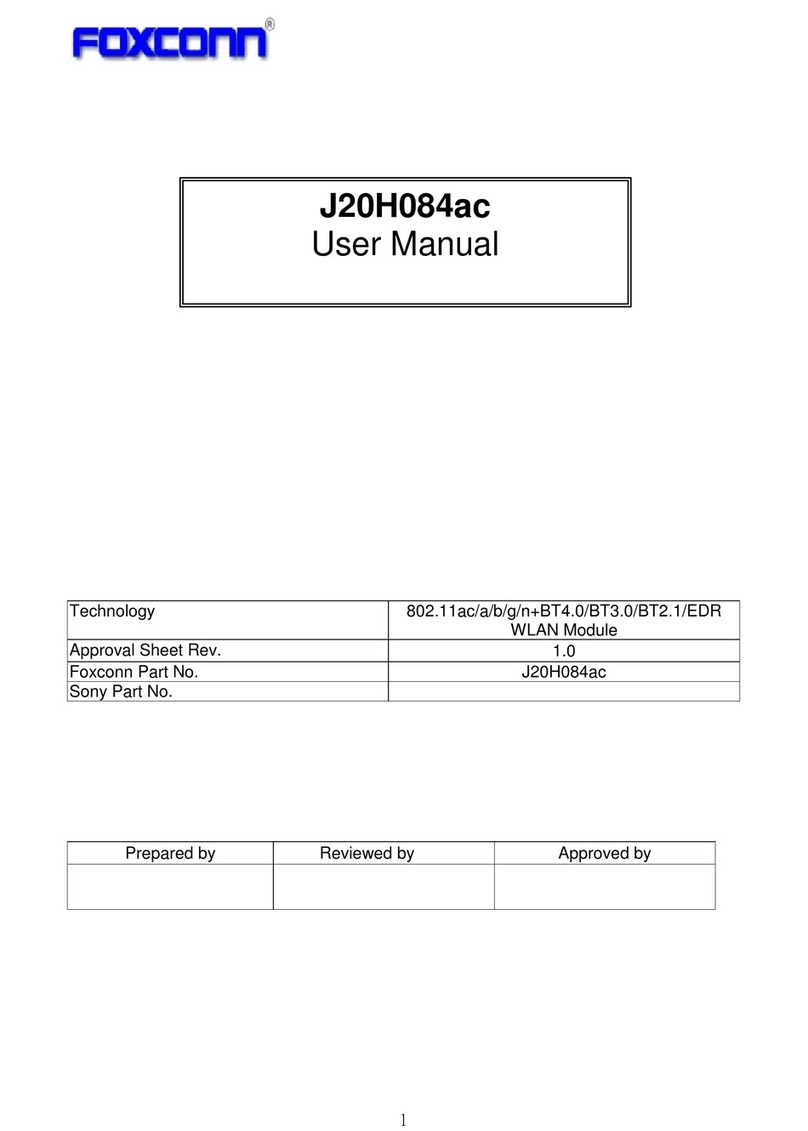High-Flying HF-LPT270 User manual

HF-LPT270 Series Wi-Fi&BLE User Manual
Shanghai High-Flying Electronics Technology Co., Ltd(www.hi-flying.com) - 1 -
HF-LPT270
Low Power Wi-Fi + BLE Module
User Manual
V 1.0
Overview of Characteristic
Support Wi-Fi IEEE802.11b/g/n and BLE5.0 Wireless Standards
Based on RISC SOC, 160MHz CPU, 276KB RAM, 2MB Flash
Support UART Data Communication with Wi-Fi or BLE
Support Wi-Fi STA/AP Mode
Support BLE SmartBLELink Config
Support Wi-Fi AP SmartAPLink and Sniffer SmartLink V8 Config
Support Wireless and Remote Firmware Upgrade Function
Support Software SDK for Develop
Support Different Antenna Option
HF-LPT270-0(F):External 1st IPEX or Antenna Pad Out
Single +3.3V Power Supply for HF-LPT270-0(F)
Size:
HF-LPT270-0(F):22.5mm x 13.5mm x 3mm, SMT18 package

HF-LPT270 Series Wi-Fi&BLE User Manual
Shanghai High-Flying Electronics Technology Co., Ltd(www.hi-flying.com) - 2 -
TABLE OF CONTENTS
LIST OF FIGURES...................................................................................................................................3
LIST OF TABLES ....................................................................................................................................4
HISTORY..................................................................................................................................................5
1. PRODUCT OVERVIEW ................................................................................................................6
1.1. General Description.................................................................................................................6
1.1.1 Key Application...................................................................................................................6
1.1.2 Device Paremeters.............................................................................................................6
1.2. Hardware Introduction.............................................................................................................7
1.2.1. HF-LPT270-0(F) Pins Definition .........................................................................................8
1.2.2. Electrical Characteristics ..................................................................................................10
1.2.3. HF-LPT270-0(F) Mechanical Size....................................................................................11
1.2.4. On-board Chip Antenna....................................................................................................12
1.2.5. External Antenna..............................................................................................................12
1.2.6. Evaluation Kit....................................................................................................................13
1.2.7. Order Information..............................................................................................................14
1.2.8. Hardware Typical Application...........................................................................................15
APPENDIX D: CONTACT INFORMATION ......................................................................................18

HF-LPT270 Series Wi-Fi&BLE User Manual
Shanghai High-Flying Electronics Technology Co., Ltd(www.hi-flying.com) - 3 -
LIST OF FIGURES
Figure1 HF-LPT270-0(F) Appearance .....................................................................................................7
Figure 1. HF-LPT270-0(F) Pins Map.....................................................................................................8
Figure 2. HF-LPT270-0(F)-2 Antenna PAD Out....................................................................................9
Figure 3. HF-LPT270-0(F) Mechanical Dimension..............................................................................11
Figure 4. Suggested Module Placement Region.................................................................................12
Figure 5. 1st IPEX Connector...............................................................................................................13
Figure 6. HF-LPX70 EVK Type Two....................................................................................................14
Figure 7. HF-LPT270 Order Information.............................................................................................15

HF-LPT270 Series Wi-Fi&BLE User Manual
Shanghai High-Flying Electronics Technology Co., Ltd(www.hi-flying.com) - 4 -
LIST OF TABLES
Table1. HF-LPT270-0(F) Module Technical Specifications ................................................................6
Table2. HF-LPT270-0(F) Pins Definition.............................................................................................8
Table3. Absolute Maximum Ratings:.................................................................................................10
Table4. External Antenna Parameters..............................................................................................13
Table5. Evaluation Kit Interface Description .....................................................................................14

HF-LPT270 Series Wi-Fi&BLE User Manual
Shanghai High-Flying Electronics Technology Co., Ltd(www.hi-flying.com) - 6 -
1.PRODUCT OVERVIEW
1.1. General Description
The HF-LPT270-0(F) module is a fully self-contained small form-factor, single stream,
802.11b/g/n Wi-Fi + BLE module, which provide a wireless interface to any equipment with a Serial
interface for data transfer. This module integrate MAC, baseband processor, RF transceiver with
power amplifier in hardware and all Wi-Fi protocol and configuration functionality and networking stack,
in embedded firmware to make a fully self-contained 802.11b/g/n Wi-Fi and BLE solution for a variety
of applications.
The HF-LPT270-0(F) module employs the world's lowest power consumption embedded
architecture. It has been optimized for all kinds of client applications in the home automation, smart
grid, handheld device, personal medical application and industrial control that have lower data rates,
and transmit or receive data on an infrequent basis.
1.1.1 Key Application
Remote equipment monitoring
Asset tracking and telemetry
Security
Industrial sensors and controls
Home automation
Medical devices
1.1.2 Device Paremeters
Table1. HF-LPT270-0(F) Module Technical Specifications
Class
Item
Parameters
Wi-Fi
Parameters
Wireless standard
802.11 b/g/n
Frequency range
2.412GHz-2.472GHz
Transmit Power
802.11b: +16dBm ± 2dBm (@11Mbps)
802.11g: +14dBm ± 2dBm (@54Mbps)
802.11n: +13dBm ± 2dBm (@HT20, MCS7)
Receiver Sensitivity
802.11b: -98 dBm (@1Mbps)
802.11b: -91dBm (@11Mbps)
802.11g: -93dBm (@6Mbps)
802.11g: -77dBm (@54Mbps)
802.11n: -93dBm (@MCS0)
802.11n: -73 dBm (@MCS7)
BLE
Parameters
Wireless standard
BLE5.0
Frequency range
2.402GHz-2.480GHz
Transmit Power
Max 15dBm
Receiver Sensitivity
-90dBm

HF-LPT270 Series Wi-Fi&BLE User Manual
Shanghai High-Flying Electronics Technology Co., Ltd(www.hi-flying.com) - 7 -
Hardware
Parameters
Antenna Option
HF-LPT270-0(F):
External: 1st IPEX antenna or PAD out
Data Interface
UART
GPIO, SPI, PWM, ADC
Operating Voltage
2.7~3.6V
Operating Current
Peak (1ms for every 100ms): <350mA
Average(STA, No data): 45mA
Average(STA, Continuous TX): 60mA
Average(AP): 70mA
Standby: 200uA (Reset Pin set to low)
Operating Temp.
-40℃- 85℃
Storage Temp.
-40℃- 125℃
Humidity
<85%
MSL
Level 3
Dimensions and Size
HF-LPT270-0(F):
22.5mm x 13.5mm x 3mm
Software
Parameters
Network Type
STA/AP
Security Mechanisms
WEP/WPA-PSK/WPA2-PSK
Encryption
WEP64/WEP128/TKIP/AES
Update Firmware
Local Wireless, Remote OTA
Customization
Support SDK for application develop
Network Protocol
IPv4, TCP/UDP/HTTP/TLS(SDK)
User Configuration
AT+instruction set.
SmartBLELink BLE Config
SmartAPLink AP Config
SmartLink Config
1.2. Hardware Introduction
HF-LPT270-0(F) Wi-Fi module appearance is as following.
Figure1 HF-LPT270-0(F) Appearance

HF-LPT270 Series Wi-Fi&BLE User Manual
Shanghai High-Flying Electronics Technology Co., Ltd(www.hi-flying.com) - 8 -
1.2.1. HF-LPT270-0(F) Pins Definition
Figure 1. HF-LPT270-0(F) Pins Map
Table2. HF-LPT270-0(F) Pins Definition
Pin
Describtion
Net Name
Signal
Type
Comments
1
UART1_TX
DEBUG_UART1_TX
O
3.3V TTL UART1 Debug Output
GPIO17
2
UART1_RX
DEBUG_UART1_RX
I
3.3V TTL UART1 Debug Input
GPIO11
3
GPIO12
GPIO12
I/O
GPIO12
4
GPIO14
GPIO14
I/O
GPIO14
5
UART0
UART0_TX
O,PU
3.3V TTL UART0 Communication Output
GPIO16
6
UART0
UART0_RX
I
3.3V TTL UART0 Communication Input
GPIO7
7
GPIO8
I/O
Boot Select, default low, leave it
unconnected.
Low: boot from flash.
High: boot from UART.
8
NC
9
NC
10
Module Reset
RESET
I,PU
“Low” effective reset input. There is RC
reset circuit internally. No need of external
RC reset circuit.
11
Module Boot Up
Indicator
nReady
O
“0” – Boot-up OK;
“1” – Boot-up Fail;

HF-LPT270 Series Wi-Fi&BLE User Manual
Shanghai High-Flying Electronics Technology Co., Ltd(www.hi-flying.com) - 9 -
Pin
Describtion
Net Name
Signal
Type
Comments
GPIO4, PWM2
12
Multi-Function
nReload
I,PU
Detailed functions see <Notes>
GPIO3, PWM3
13
Wi-Fi Status
nLink
O
“0” – Wi-Fi connect to router
“1” – Wi-Fi unconncted;
Detailed functions see <Notes>
GPIO5
14
NC
15
+3.3V Power
VDD
Power
16
Ground
GND
Power
17
ANT
Signal
Only -0 and -2 have these two pins
Antenna Pad Out. See following for detailed.
18
Ground
GND
Power
-0 use external IPEX antenna.
-2 use antenna PAD out, there is two pins can be used, recommend to use PIN17.
Figure 2. HF-LPT270-0(F)-2 Antenna PAD Out
<Notes>
I —Input;O —Output
PU—Internal Resistor Pull Up;I/O: Digital I/O;Power—Power Supply
nReload Pin (Button) function:
1. When this pin is set to “low” during module boot up, the module will enter wireless
firmware and config upgrade mode. This mode is used for customer manufacture.
See Appendix to download software tools for customer batch configuration and
upgrade firmware during mass production.
2. After module is powered up, short press this button (0.2s < “Low” < 1.5s) and loose
to make the module go into SmartBLELink config mode, waiting for APP to set router
SSID and password, config module connect to router. Recommend to use
SmartBleLink BLE method config, may use AT+SMARTCONFIG to choose other
config mode(SmartLink V8 and SmartAPLink).
See Appendix to download SmartBLELink, SmartLink V8 and SmartAPLink APP
3. After module is powered up, long press this button ( “Low” > 4s ) and loose to make
the module recover to factory setting.

HF-LPT270 Series Wi-Fi&BLE User Manual
Shanghai High-Flying Electronics Technology Co., Ltd(www.hi-flying.com) - 10 -
High-Flying strongly suggest customer fan out this pin to connector or button for
“Manufacture” upgrade or “SmartLink” application.
nReady Pin (LED) function(Low effective):
1. OS initial finished indicator. Only after this pin output low, can the UART function be
used.
nLink Pin (LED) function(Low effective):
1. At wireless firmware and config upgrade mode , this LED used to indicate configure
and upgrade status.
2. At “SmartLink”config mode, this LED is used to indicate APP to finish setting.
3. At normal mode, it’s Wi-Fi link status indicator. Output Low when STA mode connect
to router AP or other STA connect to it when in AP mode.
High-Flying strongly suggest customer fan out this pin to LED.
UART1 Debug :
1. Is used for debug log or firmware program, baud rate 921600.
1.2.2. Electrical Characteristics
Table3. Absolute Maximum Ratings:
Parameter
Condition
Min.
Typ.
Max.
Unit
Work temperature range
-40
85
°C
Maximum soldering temperature
IPC/JEDEC J-STD-020
260
°C
ESD (Human Body Model HBM)
TAMB=25°C
2.5
KV
ESD (MM)
TAMB=25°C
0.25
KV

HF-LPT270 Series Wi-Fi&BLE User Manual
Shanghai High-Flying Electronics Technology Co., Ltd(www.hi-flying.com) - 12 -
1.2.4. On-board Chip Antenna
HF modules support internal on-board chip antenna option. When customer select internal antenna,
you shall comply with following antenna design rules and module location suggestions:
For customer PCB, module antenna area can’t put componet or paste GND net;(See the
following red arrow area)
Antenna must away from metal or high components at least 10mm;
Antenna can’t be shieldedby any meal enclosure; All cover, include plastic, shall away from
antenna at least 10mm;
High-Flying suggest module better locate in following region at customer board, which to reduce the
effect to antenna and wireless signal, and better consult High-Flying technical people when you
structure your module placement and PCB layout.
Figure 4. Suggested Module Placement Region
1.2.5. External Antenna
HF-LPT270-0(F) module supports external antenna(I-PEX) option for user dedicated application.
If user select external antenna,HF-LPT270-0(F) Wi-Fi modules must be connected to the 2.4G
antenna according to IEEE 802.11b/g/n standards. We can provide external antenna if needed.
Contact with our salesman.

HF-LPT270 Series Wi-Fi&BLE User Manual
Shanghai High-Flying Electronics Technology Co., Ltd(www.hi-flying.com) - 13 -
Figure 5. 1st IPEX Connector
The antenna parameters required as follows:
Table4. External Antenna Parameters
Item
Parameters
Frequency range
2.4~2.5GHz
Impedance
50 Ohm
VSWR
2 (Max)
Return Loss
-10dB (Max)
Connector Type
I-PEX or populate directly
1.2.6. Evaluation Kit
High-Flying provides the EVK to promote user to familiar the product and develop the detailed
application. The evaluation kit shown as below, user can connect to module with the RS-232 UART,
USB (Internal USB to UART convetor) or Wireless interface to configure the parameters, manage the
module or do the some functional tests.

HF-LPT270 Series Wi-Fi&BLE User Manual
Shanghai High-Flying Electronics Technology Co., Ltd(www.hi-flying.com) - 14 -
Figure 6. HF-LPX70 EVK Type Two
Notes: User need download USB to UART port driver from High-Flying web or contact with technical
support people for more detail.
The external interface description for evaluation kit as follows:
Table5. Evaluation Kit Interface Description
1.2.7. Order Information
Base on customer detailed requirement, HF-LPT270 modules provide different variants and physical
type for detailed application.
Function
Name
Description
External
Interface
RS232
Main data/command RS-232 interface, this
interface maximum baud rate is 460800. Can not
be used for debug UART log(It need 921600)
USB
USB to UART interface, can be used for debug
UART log
DC5V
DC jack for power in, 5~9V input.
LED
Power
Power LED
Ready
nReady LED
Link
nLink LED
Button
nReload
Smartlink and Restore factory default configuration.
See more for PIN Definition

HF-LPT270 Series Wi-Fi&BLE User Manual
Shanghai High-Flying Electronics Technology Co., Ltd(www.hi-flying.com) - 15 -
Figure 7. HF-LPT270 Order Information
1.2.8. Hardware Typical Application
Notes:
nReset- Module hardware reset signal. Input. Logics “0” effective.
There is pull-up resister internal and no external pull-up required. When module power up or some
issue happened, MCU need assert nRST signal “0” at least 10ms, then set”1” to keep module fully
reset.
nLink- Module WIFI connection status indication. Output.
(This pin is recommend to connect to LED, indicate status when the module in wireless
upgrade mode)
When module connects to AP (AP associated), this pin will output “0”. This signal used to judge if
module already at WiFi connection status. Thers is pull-up resister internal and no external pull-up
required. If nLink function not required, can leave this pin open.
nReady- Module boot up ready signal. Output. Logics “0” effective.
The module will output “0” after normal boot up. This signal used to judge if module finish boot up and
ready for application or working at normal mode. If nReady function not required, can leave this pin
open.
nReload- Module restore to factory default configuration.Input. Logics “0” effective.
(This pin is recommend to connect to button, is used to enter wireless upgrade mode)
User can de-assert nReload signal “0” more than 4s through button or MCU pin, then release, module
will restore to factory default configuration and re-start boot up process.. If nReload function not
required, can leave this pin open.
UART0_TXD/RXD- UART port data transmit and receive signal.

HF-LPT270 Series Wi-Fi&BLE User Manual
Shanghai High-Flying Electronics Technology Co., Ltd(www.hi-flying.com) - 16 -
1.2.9 Warning
This equipment has been tested and found to comply with the limits for a Class B digital device,
pursuant to Part 15 of the FCC Rules. These limits are designed to provide reasonable protection
against harmful interference in a residential installation. This equipment generates, uses and can
radiate radio frequency energy and, if not installed and used in accordance with the instructions, may
cause harmful interference to radio communications. However, there is no guarantee that interference
will not occur in a particular installation. If this equipment does cause harmful interference to radio or
television reception, which can be determined by turning the equipment off and on, the user is
encouraged to try to correct the interference by one of the following measures:
- Reorient or relocate the receiving antenna.
- Increase the separation between the equipment and receiver.
- Connect the equipment into an outlet on a circuit different from that to which the receiver is
connected.
- Consult the dealer or an experienced radio/TV technician for help.
FCC Caution: Any changes or modifications not expressly approved by the party responsible for
compliance could void the user's authority to operate this equipment.
This device complies with Part 15 of the FCC Rules. Operation is subject to the following two
conditions:
(1) This device may not cause harmful interference, and
(2) This device must accept any interference received, including interference that may cause
undesired operation.
This equipment complies with FCC radiation exposure limits set forth for an uncontrolled environment.
This equipment should be installed and operated with minimum distance 20cm between the radiator &
your body. This transmitter must not be co-located or operating in conjunction with any other antenna
or transmitter.
In the event that these conditions can not be met (for example certain laptop configurations or co-
location with another transmitter), then the FCC authorization is no longer considered valid and the
FCC ID can not be used on the final product. In these circumstances, the OEM integrator will be
responsible for re-evaluating the end product (including the transmitter) and obtaining a separate FCC
authorization.

HF-LPT270 Series Wi-Fi&BLE User Manual
Shanghai High-Flying Electronics Technology Co., Ltd(www.hi-flying.com) - 17 -
Please notice that if the FCC identification number is not visible when the module is installed inside
another device, then the outside of the device into which the module is installed must also display a
label referring to the enclosed module. This exterior label can use wording such as the following:
“Contains FCC ID:2ACSHF-LPT270-0F” any similar wording that expresses the same meaning may
be used.
The module is limited to OEM installation only.
The module is limited to installation in mobile or fixed application.
The OEM integrator is responsible for ensuring that the end-user has no manual instruction to remove
or install module.
A separate approval is required for all other operating configurations, including portable configurations
with respect to Part 2.1093 and difference antenna configurations.
There is requirement that the grantee provide guidance to the host manufacturer for compliance with
Part 15B requirements.

HF-LPT270 Series Wi-Fi&BLE User Manual
Shanghai High-Flying Electronics Technology Co., Ltd(www.hi-flying.com) - 18 -
APPENDIX D: CONTACT INFORMATION
------------------------------------------------------------------------------------------------------------
Address:Building 17, No.1500 Zu Chongzhi Road,Pudong District, 201203, Shanghai, China
Web: www.hi-flying.com
Service Online: 400-189-3108/18616078755
Sales Contact: sales@hi-flying.com
-----------------------------------------------------------------------------------------------------------
For more information about High-Flying modules, applications, and solutions, please visit our web site
http://www.hi-flying.com/en/
<END OF DOCUMENT>
© Copyright High-Flying, May, 2011
The information disclosed herein is proprietary to High-Flying and is not to be used by or disclosed to
unauthorized persons without the written consent of High-Flying. The recipient of this document shall respect the
security status of the information.
The master of this document is stored on an electronic database and is “write-protected” and may be altered only
by authorized persons at High-Flying. Viewing of the master document electronically on electronic database
ensures access to the current issue. Any other copies must be regarded as uncontrolled copies.
Other manuals for HF-LPT270
1
Table of contents
Other High-Flying Wireless Module manuals


